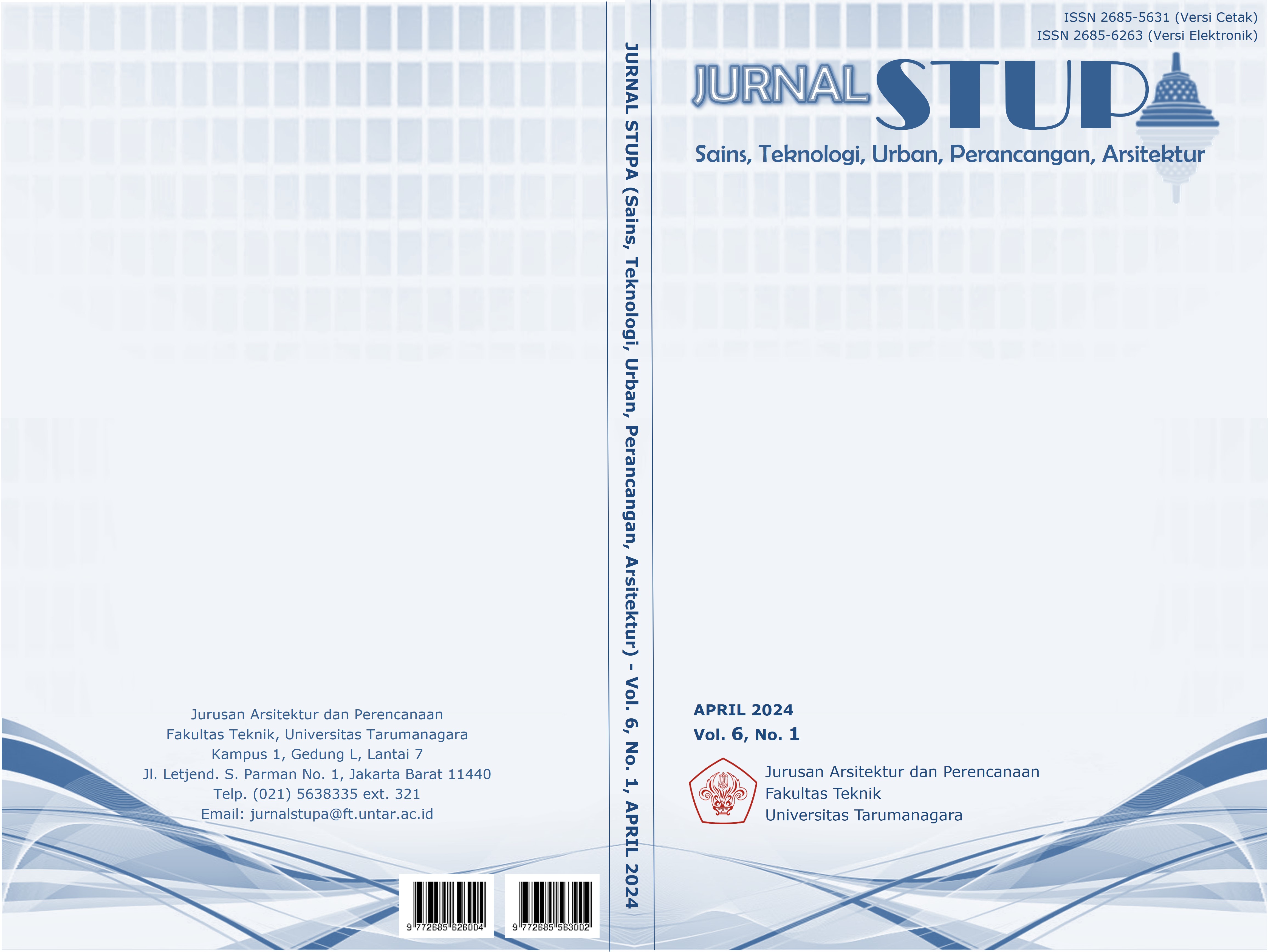PENGOPTIMALAN PERANCANGAN RUANG ARSITEKTUR MELALUI KEGIATAN MENENUN MASYARAKAT ENDE
Main Article Content
Abstract
Traditions play a central role in the lives of people in many parts of Indonesia, and that includes the region of Ende, East Nusa Tenggara. Ende, which is rich in unique traditions and culture, not only sees traditional customs as an ancestral heritage, but also as an element of identity, social guidance, and community glue. Even in the face of changing times, the people of Ende remain closely connected to the values and norms of customs passed down from generation to generation. Customs provide guidance in various aspects of daily life, including in traditional governance systems, religious ceremonies, marriage, agriculture, personal traits of people, and other areas. But over time, the traditions and also the guidance of the people's lives there began to disappear. Where the Ende community used to do weaving activities together, they now do it individually in their individual homes. Many things make this happen, for example because of the individualistic nature of the community, changing times, technological developments, and others. Due to these things, the people there began to forget their traditions. However, despite facing challenges from globalization, urbanization, and modernization, the people of Ende strive to maintain and apply their customs. This research uses qualitative methods in order to produce a comprehensive synthesis which aims to better understand the essential needs of the people living in the area. This project aims to find out the potential role of architecture in shaping the ideal architectural space to accommodate all the activities of the Ende community based on local traditions.
Keywords: community; identity; individual; society; traditions
Abstrak
Adat istiadat memiliki peran utama dalam kehidupan masyarakat di berbagai daerah Indonesia, hal itu termasuk di wilayah Ende, Nusa Tenggara Timur. Ende, kaya akan tradisi dan budaya unik, tidak hanya melihat adat istiadat sebagai warisan leluhur, tetapi juga sebagai elemen identitas, panduan sosial, dan perekat komunitas. Walaupun dihadapkan pada perubahan zaman, masyarakat Ende tetap terhubung erat dengan nilai-nilai dan norma adat istiadat yang diwariskan dari generasi ke generasi. Adat istiadat memberikan pedoman dalam berbagai aspek kehidupan, termasuk dalam sistem pemerintahan tradisional, upacara keagamaan, pernikahan, pertanian, sifat pribadi orang, dan bidang lainnya. Tetapi lama kelamaan adat istiadat dan juga pendoman hidup masyarakat di sana mulai hilang. Yang dulunya masyarakat Ende melakukan aktivitas menenun secara bersama - sama sekarang mereka lakukan secara individu di rumahnya masing – masing. Banyak hal yang membuat tersebut terjadi, contohnya karena sifat individualis masyarakat, perubahan jaman, perkembangan teknologi, dan lain – lain. Oleh karena hal–hal tersebut masyarakat di sana mulai melupakan adat istiadat namun demikian, meskipun menghadapi tantangan dari globalisasi, urbanisasi, dan modernisasi, masyarakat Ende berusaha dengan gigih untuk mempertahankan dan menerapkan adat istiadat mereka. Penelitian ini menggunakan metode kualitatif supaya bisa menghasilkan sintesis yang komprehensif yang dimana hal ini bertujuan supaya lebih memahami kebutuhan esensial masyarakat yang tinggal di daerah tersebut. Proyek ini bertujuan untuk mengetahui sejauh mana peran arsitektur dalam membentuk ruang arsitektur yang ideal untuk mewadahi segala aktivitas masyarakat Ende berdasarkan adat istiadat setempat.
Article Details

This work is licensed under a Creative Commons Attribution-NonCommercial-ShareAlike 4.0 International License.
This work is licensed under a Jurnal Sains, Teknologi, Urban, Perancangan, Arsitektur/ STUPA Creative Commons Attribution-NonCommercial-ShareAlike 4.0 International LicenseReferences
Athanua. (2015). Profil Desa Manulondo Kecamatan Ndona. Retrieved from https://athanua.wordpress.com/2015/10/29/profil-desa-manulondo-kecamatan-ndona/
GoogleMaps. (2023). Retrieved from https://www.google.com/maps/place/Manulondo,+Kec.+Ndona,+Kabupaten+Ende,+Nusa+Tenggara+Tim.
Hidayat, F. & Yulia, A. (2021). Empathic Architecture and Its Effect on Mental Health of Building Occupants: A Literature Review. Journal of Architecture and Built Environment, 48(2), 135-145.
Ihsan D. Athanua. (2015). Mengenal Kerajinan Anyaman Ende Lio. Retrieved from https://athanua.wordpress.com/2015/11/27/mengenal-kerajinan-anyaman-ende-lio/.
Kementerian Koordinator Bidang Pembangunan Manusia dan Kebudayaan Republik Indonesia. (2022). Tenun Ikat Khas Lio Warisan Budaya Indonesia. Siaran Pers Nomor: 125/HUMAS PMK/V/2022.
Mukhtar, M. A., Pangarsa, G. W., & Wulandari, L. D. (2013). Struktur konstruksi arsitektur tradisional bangunan tradisional keda suku ende lio di permukiman adat wolotolo. RUAS (Review of Urbanism and Architectural Studies), 11(1), 16-27.
Melalatoa, M. Junus. (1995). Enskilopedi Suku Bangsa di Indonesia Jilid A-K. Jakarta: Departemen Pendidikan dan Kebudayaan RI.
Nikita Rosa Damayanti Waluyo. (2022). 5 Budaya Khas Daerah NTT, Ada Tradisi Lempar Kerbau!. Retrieved from https://www.detik.com/edu/detikpedia/d-6107738/5-budaya-khas-daerah-ntt-ada-tradisi-lempar-kerbau.
Rizky Setiawan. (2022). Mengenal Kain NTT Melalui Beragam Jenis dan Motif Tenun yang Bernilai Seni Tinggi. Retrieved from https://www.orami.co.id/magazine/kain-ntt.
Sheth, M. & Vyas, D. (2019). Empathic Architecture: A Human Centered Approach. International Journal of Engineering and Advanced Technology, 8(5), 518-524.
Zalewski, M. & Paszkowska, A. (2019). Empathic Architecture as a Contemporary Trend in Modern Building. MATEC Web of Conferences, 252, 06002.



